-
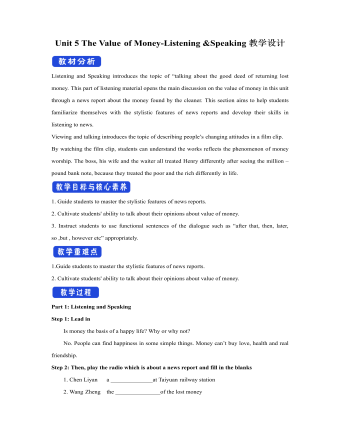
新人教版高中英语必修3Unit 5 The Value of Money-Listening &Speaking教学设计
Step 4: Listen again and decide if the following statements are true (T) or false (F).1 It was the first time Chen Liyan's story was reported. T口 F口2 Chen found 10,000 yuan in a small plastic bag in Taiyuan railway station口 F口3 Wang Zheng apologized to Chen because he couldn't offer her more money. T口 F口4 Chen took out a large loan to cure her daughter, T口 F口5 Wang set up a fundraising website for Chen's daughter after Chen told him about her situation. T口 F口Step 5:After listening, discuss the questions.1 What kind of person do you think Chen Liyan is?Chen Liyan is generous and honest because she returned a large sum of money to the owner.2 Did Chen return the money because she didn't need it?No. She returned the money because it was the right thing to do. Evidence for this is that she refused to accept the reward money because she felt that it had not been earned. 3 Is it common for people to do what Chen did?It depends on the culture. In some countries it is quite common to return money that has been found. In other countries, people believe "Finders are keepers!" 4 How did Wang Zheng feel about the return of his money?He must have been very happy and relieved to have gotten his money back. We know this because he thanked Chen repeatedly and even offered her a reward.5 Why did Ma Dongbao tell Wang about Chen's family?He must have had great sympathy for Chen and her daughter and wanted to help them.'We know this because he arranged help for them. 6 How did the news reporter feel about Chen's actions?The news reporter felt that it showed that money wasn't the most important thing in life. We know this because the reporter told us that this is what Chen believes. and then said, “that's a great attitude to take."
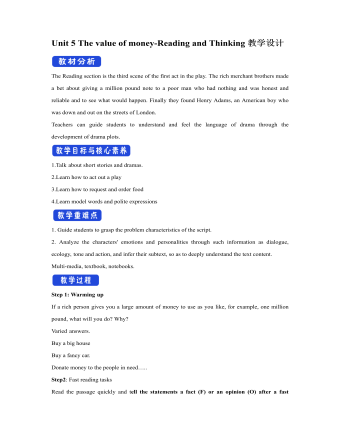
新人教版高中英语必修3Unit 5 The value of money-Reading and Thinking教学设计二
? Could you offer me some kind of work here?? I don’t want your charity, I just want an honest job.? Careless: I landed in Britain by accident.Step 7:Consolidation.? Find Henry? Roderick and Oliver were I .making a bet when they saw Henry, a poor young man. ? Know Henry? About a month ago, Henry was sailing and later he found himself carried out to sea by a strong wind. Fortunately, he 2.was spotted by a ship. And it was the ship that brought him to 3.England? Offer money to Henry ? Oliver and Roderick gave Henry a letter and told him that there was money in it. They 4.persuaded him to accept it, and made him 5.promise that it wouldn't be opened until 2 o'clock.Step 8:Language pointsa large amount of: a large quantity of; a great deal ofe.g. They bought a large amount of furniture before they moved their new house.make a bet: make an arrangement to risk money, etc. on an event of which the result is doubtful.e.g. We made a bet on the result of the match.permit sb to do something: allow somebody to do somethinge.g. My mother doesn’t permit me to ride in the street after it rained.by accident: as a result of chancee.g. I only found it by accident.stare at: look at somebody or something with the eyes wide open in a fixed gaze( in astonishment, wonder, fear, etc)to be honest: to tell you the truth; to be franke.g. To be honest, I don’t think we have a chance of winning.Step7 Homework:What do you think will happen to Henry? Will the bank-note help him or get him into trouble?
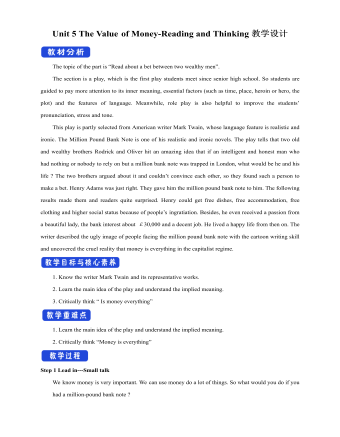
新人教版高中英语必修3Unit 5 The Value of Money-Reading and Thinking教学设计一
Everybody wants to get wealth.In today’s material world,making money or becoming wealthy symbolizes a person’s success and capability. Many people just make every effort, pay any price to attain greater wealth. With money,they can buy nice, large apartments in nice neighborhood. With money they can own luxurious cars. Wealth seems to bring all happiness in life.But is wealth the only road to happiness? Not really. There are many things in the world, which are beyond the means of money, such as friendship, love, health and knowledge. People are so preoccupied with struggling for money that they have no time or would not take the time to form or maintain friendship. What happiness can they feel living as lonely miserable creatures without love or friends in the world even if they accumulate tremendous wealth?In my opinion, people can’t do anything without money, but money is not everything. What money will bring you depends on your personal belief and goal in life. If you are kind enough to help others, especially the poor, money is a good thing to you. With it, you can do much more for the benefit of people and your country, and it will add to your own happiness. If you want money just for your own needs, you’ll never be satisfied or happy. In a word,you should have money spent for more people. Only then can money be the source of your happiness.Step 8 Homework4 students in a group, one acts Roderick, one Oliver, one servant and the fourth one acts Henry Adams, then listen to the tape, pay more attention to the difference between American English and British English in pronunciation, stress, tone.
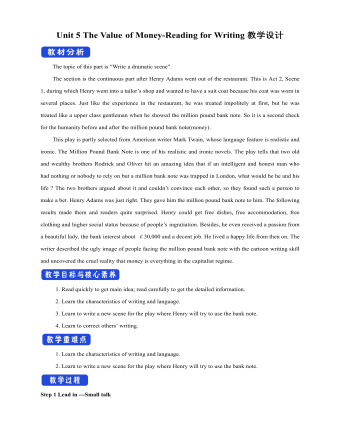
新人教版高中英语必修3Unit 5 The Value of Money-Reading for Writing教学设计二
2. 您能看到, 我头发太长了。You can see that my hair is much too long.3. 无论什么时候, 只要您想回来就回来。Please come back whenever you want.4. 您仅有很少的头发要理! You only have too little hair to cut !5. 为您服务是我的荣幸!It is my honour to serve you!Step 9 Writing(Henry is walking down the street when he sees a sign for a place that cuts hair. He decides to have it cut. )H=Henry B=BarberH: Good afternoon, I’d like to have my hair cut, if I may. (The barber looks at Henry’s hair and continues cutting another man’s hair. ) Er, I’d really like a haircut. As you can see it’s much too long. B: (in a rude manner) Yes, I can see that. Indeed, I can. H: Fine, well, I’ll have a seat then. (He sits in one of the barber’s chairs. The barber turns to look at Henry. )B: It’s quite expensive here, you know! Are you sure you can afford it?H: Yes. I think so. (After his hair is cut, the barber tells Henry how much he must pay. Henry shows the barber the bank note. )B: Why Mr. . . (looks shocked)H: Adams. Henry Adams. I’m sorry. I don’t have any change. B: Please don’t worry! (wearing a big smile) Nothing to worry about! Nothing at all! Please come back whenever you want, even if you only have too little hair to cut! It will be my honour to serve you!Step 10 Pair workExchange drafts with a partner. Use this checklist to help your partner revise his/her draft.1. Are all the elements of a play included and in good order ?2. Do the character use suitable language ?3. Are the stage directions clear and useful ?4. Is the plot clear and exciting enough ?
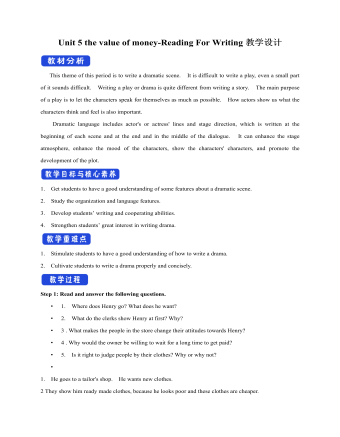
新人教版高中英语必修3Unit 5 the value of money-Reading For Writing教学设计一
【参考范文】Narrator:(Henry is smiling as he leaves the restaurant. As he is walking down the street, he sees a sign for a place that cuts hair. He decides to get it cut. )H=Henry;B=Barber;R=rude manH:Good afternoon, I'd like to get a cut, if I may. (The barber looks at Henry's hair and continues cutting another man's hair. )Er, I'd really like a haircut. As you can see it's much too long. B:(in a rude manner) Yes, I can see that. Indeed, I can. H:Fine, well I'll have a seat then. (He sits in one of the barber's chairs. The barber turns to look at Henry. )B:It's quite expensive here, you know!Are you sure you can afford it?H:Yes. I think so. (In comes the rude man. )R:Hey you there. I need a haircut quickly. Can you do me straightaway?B:All right, then, get in the chair and I'll see what I can do. R:Thank you. (sits down in one of the barber's chairs)H:Excuse me, but I was here first. Aren't you going to do my hair first?B:This man's in a hurry. H:Well so am I!I insist that you cut my hair first. B:OK, but I'll have to be quick. This gentleman is waiting. H:Thank you. (They both become quiet. After his hair is cut, the barber tells Henry how much he must pay. Henry shows the barber the bank note. )B:Why, Mr . . . (looks shocked)H:Adams. Henry Adams. I'm sorry, I don't have any change. R:You're that Mr Adams! Well,I'm glad I waited or I might never have known it was you. B:Why, Mr Adams, please don't worry!(wearing a big smile) Nothing to worry about!Nothing at all!Please come back any time, even if you only need too little hairs cut!It will be my honour to serve you!
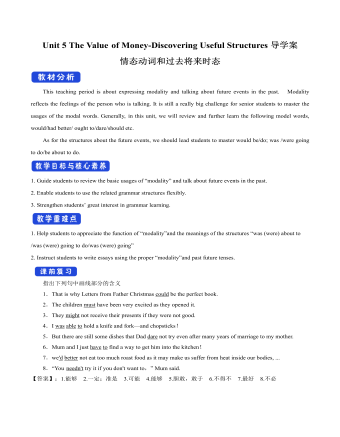
新人教版高中英语必修3Unit 5 The Value of Money-Discovering Useful Structures导学案
4.They were going to find someone to take part in their bet when they saw Henry walking on the street outside.[归纳]1.过去将来时的基本构成和用法过去将来时由“would+动词原形”构成,主要表示从过去某一时间来看将要发生的动作(尤其用于宾语从句中),还可以表示过去的动作习惯或倾向。Jeff knew he would be tired the next day.He promised that he would not open the letter until 2 o'clock.She said that she wouldn't do that again.2.表示过去将来时的其他表达法(1)was/were going to+动词原形:该结构有两个主要用法,一是表示过去的打算,二是表示在过去看来有迹象表明将要发生某事。I thought it was going to rain.(2)was/were to+动词原形:主要表示过去按计划或安排要做的事情。She said she was to get married next month.(3)was/were about to+动词原形:表示在过去看来即将要发生的动作,由于本身已含有“即将”的意味,所以不再与表示具体的将来时间状语连用。I was about to go to bed when the phone rang.(4)was/were+现在分词:表示在过去看来即将发生的动作,通常可用于该结构中的动词是come,go,leave,arrive,begin,start,stop,close,open,die,join,borrow,buy等瞬间动词。Jack said he was leaving tomorrow.

人教版高中英语必修4Women of achievement说课稿4篇
Good morning, distinguished judges:It’s my honor to talk about my teaching ideas with you. Today my topic is Women of Achievement. My presentation consists of six parts: the analysis of teaching material and student, teaching aims, key and difficult points, teaching and studying method, teaching procedures and blackboard design.First, let’s focus on the analysis of teaching material. This lesson is from New Senior English for China Student’s Book 4 Unit 1, the reading part. The main topic of the passage is the introduction of a student of Africanwildlife. After this lesson, the students will learn more information about her studying chimps in Africa, and their reading and speaking abilities can be developed as well.The next part is the analysis of students. My students are in senior high students. They have learnt English for many years, they’ve known many words and sentences, but their speaking and reading abilities are still not very good. So I will practice their speaking and reading abilities through different exercises.According to the New Standard Curriculum and the present situation, I set the teaching aims as follows: firstly, knowledge aims. Students can grasp some new words, such as worthwhile, move off. Moreover, students can understand the content of the passage and get familiar with the topic of studying chimps in wildlife. Secondly, ability aims. Students can use reading strategies such as skimming and scanning in reading process. Thirdly, emotional aims. Students can have the awareness of protecting animals and care about animals.Based on the above analysis, the key point of this lesson is to get the main idea and the detailed information from the passage; the difficult point is to talk about the wildlife protection and use reading strategies.

人教版高中英语必修4A taste of English Humor说课稿3篇
Then I would ask them to think of a funny English or Chinese and tell it to partners. While telling stories, they can use expressions and some acting to help make the story funny. 5 minutes would be given to do this.Those stories they told there will be the material for their writing. Soletting them tell it at first is helpful. And they can make a difference between telling a funny story and writing it down. Generally speaking, it is difficult forstudents to write well because they don’t know what to write and how to write. Asking them to tell their own stories at first can help them come up with what to write.After their telling, I would invite someone to share his/her story with all of us and I would write it down on the blackboard.This example story would be used as a sample to illustrate the format of funny story. Different from a story from teacher or textbook, a story from students can obviously become a interesting material to draw students’ attention.Then I would ask the whole class to put this story into several parts. It might be a little bit difficult for them. So I would ask them to find out whether all the sentences are necessary. After delete some sentences, there are 6 sentences left behind. Then they can easily put them into three parts. After interaction with students, I would teach them the right terms for each part and conclude the format of funny story.This step is the key and difficult point in my lesson. So I mainly usetask-based teaching method in this part and the task for students was divided into several stages. With the separated difficult level, students can find there are usually three parts in writing. They can also learn to write without the unnecessary parts in the process of analyzing. And then I wouldn’t rush to tell them the right terms to them directly. Instead, I would ask them to name them by their own. A confused mind is better for acquiring knowledge.While-writing:Then I would give students 7 minutes to write down this story, without other requirements.With all the preparations in pre-writing, students’ difficulties were cleared. So it would be much easier for them to write down the story within 7 minutes. There are no other requirements because students’ first writing is actually a drafting. It would be revise and edit several times later. Writing, as a skill
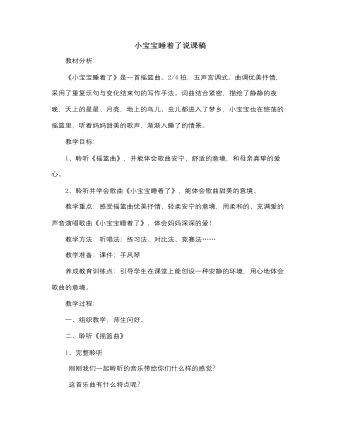
人音版小学音乐一年级下小宝宝睡着了说课稿
三、聆听、表演《小宝宝睡着了》 1、聆听歌曲启发学生说说听到歌曲时感受到了什么?2、复听,跟着歌曲,轻柔地拍节拍。 3、听琴声逐句学唱歌曲。 4、指导学生用连贯、轻柔的声音,唱准、唱好歌曲。 5、重点引导学生说说结尾的处理方式——对比练习,看哪一种方法更恰当 6、引导学生用自己创作的方式为歌曲伴奏、伴舞。 四、小结。 教学反思:一年级课堂上会有一些学生在上课的时候出现喊唱的现象,我在歌曲处理这一环节对歌曲的意境作了这样的描述:静静的夜晚,天上的星星睡了、月亮睡了、地上的鸟儿、虫儿也都进入了梦乡,小宝宝也在悠荡的摇篮里,听着妈妈甜美的歌声,渐渐入睡了。同学们妈妈哄宝宝睡觉唱歌的声音应该是欢快的,还是轻柔的?经过我的描绘和讲解学生理解了在演唱摇篮曲时应该用轻柔的声音,要把每一句都连贯的唱起来,不仅句与句之间要连贯,第一、第二段也要衔接紧凑,轻轻的哼唱出来,体会妈妈哄小宝宝睡觉时是多么的温柔。
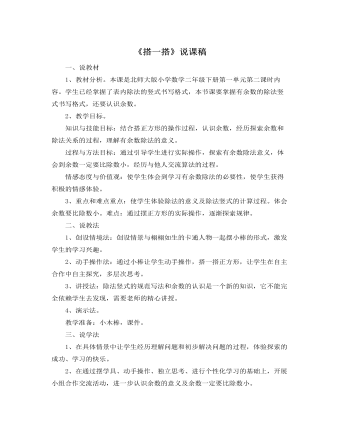
北师大版小学数学二年级下册《搭一搭》说课稿
(1)课件显示搭正方形的画面以及问题“4根小棒搭一个正方形,13根小棒可以搭多少个正方形,还剩几根?”。(2)组织小组讨论:有13根小棒,能搭几个正方形?请每个同学利用学具摆一摆,再依据上节课学习的除法算式,小组内讨论用竖式怎样表示。【设计意图:通过摆小棒搭正方形和自主探究等开发学生思维,促进学生多层次思考,培养孩子良好的思维方式,推动学生积极思考,逐步开阔学生解决问题的思路,培养学生横向思维能力。】(3)进行全班交流。指名回答;引导学生探究竖式各数表示的意思及单位名称的写法,并进一步认识余数。课件显示搭小棒的过程及横式和竖式:13÷4=3(个)……1(根)答:可以搭3个正方形,还剩1根。引导学生认识竖式中:“13”表示把13根小棒拿去分,“4”表示摆一个正方形需要4根小棒,“3”表示可以摆3个正方形(强调单位“个”),“12”表示3个正方形共12根(4×3=12)。“1”表示摆了3个后还剩下1根(强调单位:“根”),说明“1”是这个竖式的余数,这1根不能再继续往下分了。

北师大版小学数学二年级下册《分草莓》说课稿
二、说教学目标:1、探索有余数除法的试商方法,让学生再探索、练习中积累有余数除法的试商经验。2、运用有余数除法的有关知识,联系生活实际解决简单的问题,体验成功的喜悦。三、说教学重难点:1、让学生经历试商的过程,积累试商的经验,逐步达到熟练程度。2、使学生理解和掌握有余数除法的试商方法。体会余数要比除数小。四、说教学方法:探究、自主合作交流。五、说教具:课件、六、说教学过程:由于二年级学生,他们活泼好动,争强好胜,想象丰富,求知欲旺盛;学习责任感不断增强,但学习往往从兴趣出发;他们注意力不稳定、不持久,无意注意占主导地位,缺乏独立思考能力,容易受外界事物的干扰。因此,教学中培养学生参与数学活动的兴趣,培养良好的学习习惯,帮助他们逐步树立自信、自尊、自律等积极心态,是他们通过思考,提高自我认知能力,自我控制能力,这是提高课堂教学效益的基础,也是教师需努力和强化之处。下面我将详细说说我的教学过程:
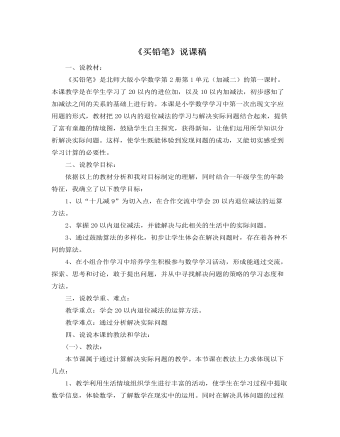
北师大版小学数学一年级下册《买铅笔》说课稿
2、求还剩多少枝要用什么方法来计算?(请几名学生说一说,再同桌互相说一说,在说的过程中掌握解决问题的方法)3、为什么用减法?你是怎么想的?(请几名学生说一说)师:你能根据要求列出算式来吗?(请学生在纸上列算式)(学生经过10以内的加减法的学习以及20以内进位加法的学习和长时间的培养,已经具备了根据数学问题列出式子的能力。因此学生根据问题,能很快的列出式子。)请学生回答。老师板书:15-9=(分析:1,“15,9”分别表示什么?)4、你是怎么来计算的(先让学生进行自主的探究,寻找计算方法。探究性学习必须要有独立思考的时间。由于学生的学习能力存在差异,对15-9的理解也存在不同,只有让学生经过独立思考,才能让他们真正的掌握知识。)
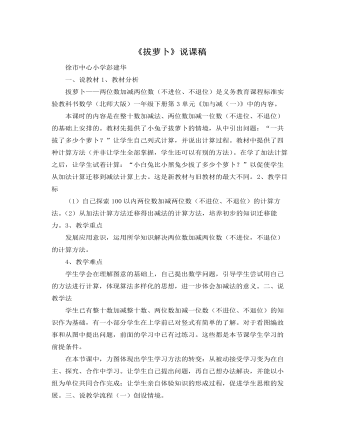
北师大版小学数学一年级下册《拔萝卜》说课稿
发展应用意识,运用所学知识解决两位数加减两位数(不进位,不退位)的计算方法。4、教学难点学生学会在理解图意的基础上,自己提出数学问题,引导学生尝试用自己的方法进行计算,体现算法多样化的思想,进一步体会加减法的意义。二、说教学法学生已有整十数加减整十数、两位数加减一位数(不进位、不退位)的知识作为基础,有一小部分学生在上学前已对竖式有简单的了解。对于看图编故事和从图中提出问题,前面的学习中已有过练习。这些都是本节课学生学习的前提条件。在本节课中,力图体现出学生学习方法的转变:从被动接受学习变为在自主、探究、合作中学习。让学生自己提出问题,再自己想办法解决,并能以小组为单位共同合作完成;让学生亲自体验知识的形成过程,促进学生思维的发展。三、说教学流程(一)创设情境。

北师大版小学数学一年级下册《采松果》说课稿
一、说教材分析《采松果》一课讲的主要内容是:两位数加、减一位数(不进位、不退位),是在学生熟练掌握20以内加、减法以及整十数加、减整十数的基础上安排的。教材内容分为两部分:一部分是教学两位数加一位数,另一部分是教学两位数减一位数。这两部分内容呈现在同一情境图——“采松果”中,创设了一个充满童趣的生活故事场景,引发学生在读懂图意的基础上,发现其中的数学信息,并能利用这些数学信息提出数学问题。二、说学情分析在学习本节课内容之前,学生已认识了100以内的数,掌握了20以内的加减法以及整十数加、减整十数的计算方法,对于加减法的意义有了一个基本的了解。另外经过上半学期的目标性训练,学生已具有了初步的合作交流意识和提出问题、解决问题的能力,能够有目的地进行探索性学习。但是,对于单纯的口算学习学生的学习兴趣并不是很浓,因此,激发学生的学习兴趣,使学生想学、乐学便显得尤为重要。
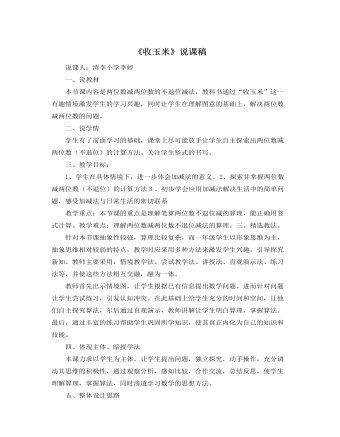
北师大版小学数学一年级下册《收玉米》说课稿
二、说学情学生有了前面学习的基础,课堂上尽可能放手让学生自主探索出两位数减两位数(不退位)的计算方法。关注学生竖式的书写。三、教学目标:1、学生在具体情境下,进一步体会加减法的意义。2、探索并掌握两位数减两位数(不退位)的计算方法3、初步学会应用加减法解决生活中的简单问题,感受加减法与日常生活的密切联系教学重点:本节课的重点是理解笔算两位数不退位减的算理,能正确用竖式计算。教学难点:理解两位数减两位数不退位减法的算理。三、精选教法。针对本节课抽象性较强,算理比较复杂,而一年级学生以形象思维为主,抽象思维相对较弱的特点,教学时应采用多种方法来激发学生兴趣,引导探究新知。教师主要采用:情境教学法、尝试教学法、讲授法、直观演示法、练习法等,并使这些方法相互交融,融为一体。
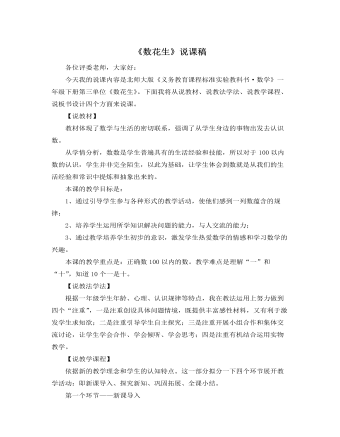
北师大版小学数学一年级下册《数花生》说课稿
各位评委老师,大家好:今天我的说课内容是北师大版《义务教育课程标准实验教科书·数学》一年级下册第三单位《数花生》。下面我将从说教材、说教法学法、说教学课程、说板书设计四个方面来说课。【说教材】教材体现了数学与生活的密切联系,强调了从学生身边的事物出发去认识数。从学情分析,数数是学生普遍具有的生活经验和技能,所以对于100以内数的认识,学生并非完全陌生,以此为基础,让学生体会到数就是从我们的生活经验和常识中提炼和抽象出来的。本课的教学目标是:1、通过引导学生参与各种形式的教学活动,使他们感到一列数蕴含的规律;2、培养学生运用所学知识解决问题的能力,与人交流的能力;3、通过教学培养学生初步的意识,激发学生热爱数学的情感和学习数学的兴趣。
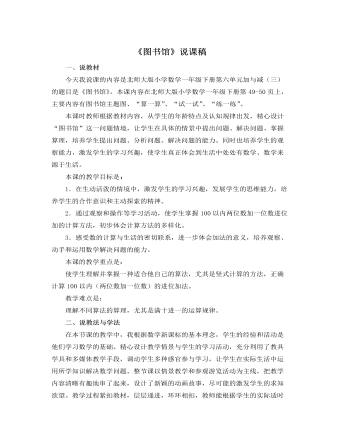
北师大版小学数学一年级下册《图书馆》说课稿
本课时教师根据教材内容,从学生的年龄特点及认知规律出发,精心设计“图书馆”这一问题情境,让学生在具体的情景中提出问题、解决问题、掌握算理,培养学生提出问题、分析问题、解决问题的能力。同时也培养学生的观察能力,激发学生的学习兴趣,使学生真正体会到生活中处处有数学、数学来源于生活。本课的教学目标是:1.在生动活泼的情境中,激发学生的学习兴趣,发展学生的思维能力,培养学生的合作意识和主动探索的精神。2.通过观察和操作等学习活动,使学生掌握100以内两位数加一位数进位加的计算方法,初步体会计算方法的多样化。3.感受数的计算与生活的密切联系,进一步体会加法的意义,培养观察、动手和运用数学解决问题的能力。本课的教学重点是:使学生理解并掌握一种适合他自己的算法,尤其是竖式计算的方法,正确计算100以内(两位数加一位数)的进位加法。教学难点是:理解不同算法的算理,尤其是满十进一的运算规律。

北师大版小学数学二年级下册《比一比》说课稿
解决了以上三个问题以后,我再让学生先独立将四座山的高度按照从小到大的顺序排列出来,这时,我会适当地引导学生阅读前面三个问题的解决过程,并梳理进行多位数比较的思路:先按数位比,再从高位看起。(三)分层次练习,巩固新知识在学生掌握了上述比较大数的方法以后,我将让学生运用所学的新知识,去解决”练一练”中的第1,2,5题。其中第1,2题是为了巩固“万以内的数的比较方法”,“能用符号表示万以内数的大小”这两个知识点;而第五题则是为了鼓励学生在新的情景中,进行数的大小比较。(四)课程总结这节课,同学们收获了什么?学生一定会很轻易地将上面四座山进行比较的规律说出来的。这时,我会引导学生回顾全文第四,板书设计(略)本节课,我将用最简单的文字体现重难点,便于学生理解。我的说课到此结束,谢谢大家!
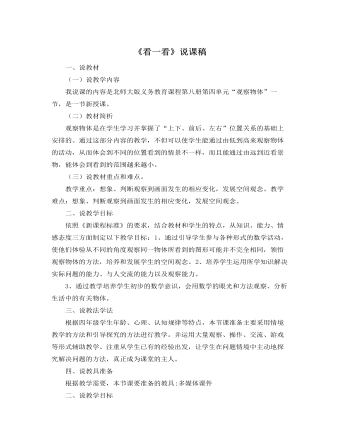
北师大版小学数学四年级下册《看一看》说课稿
一、说教材(一)说教学内容我说课的内容是北师大版义务教育课程第八册第四单元“观察物体”一节,是一节新授课。(二)教材简析观察物体是在学生学习并掌握了“上下、前后、左右”位置关系的基础上安排的。通过这部分内容的教学,不但可以使学生能通过由低到高来观察物体的活动,从而体会到不同的位置看到的情景不一样,而且能通过由远到近看景物,能体会到看到的范围越来越小。(三)说教材重点和难点。教学重点:想象、判断观察到画面发生的相应变化,发展空间观念。教学难点:想象、判断观察到画面发生的相应变化,发展空间观念。二、说教学目标依照《新课程标准》的要求,结合教材和学生的特点,从知识、能力、情感态度三方面制定以下教学目标:1、通过引导学生参与各种形式的数学活动,使他们体验从不同的角度观察同一物体所看到的图形可能并不完全相同,领悟观察物体的方法,培养和发展学生的空间观念。2、培养学生运用所学知识解决实际问题的能力、与人交流的能力以及观察能力。
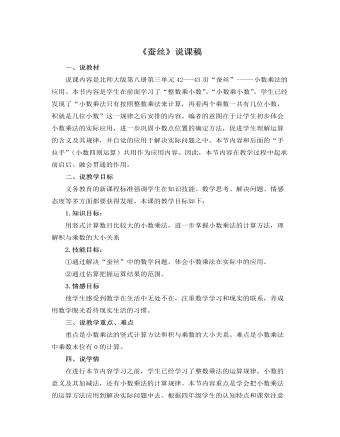
北师大版小学数学四年级下册《蚕丝》说课稿
三、说教学重点、难点重点是小数乘法的竖式计算方法和积与乘数的大小关系。难点是小数乘法中乘数末位有0的计算。四、说学情在进行本节内容学习之前,学生已经学习了整数乘法的运算规律,小数的意义及其加减法,还有小数乘法的计算规律。本节内容重点是学会把小数乘法的运算方法应用到解决实际问题中去。根据四年级学生的认知特点和课堂注意力时间有限的特点,在教学中一定要提高课堂效率五、说教法、学法在本课教学中,我采取的教学方法是:1.通过复习,回顾计算规律,并把它应用到竖式中去。2.情境展示,把数学问题直接放在实际问题中来学习并解决。3.解决问题时采用自主探索、独立思考和小组合作交流的学习方式。通过这些教学法激发学生学习的积极性和主动性,引导学生把学到的规律应用到现实生活中来解决实际问题。六、说教学过程(一)举例说明积的小数位数与乘数小数位数的关系。通过比眼力,做一做,复习前一节课所学内容,为本节课打下基础。